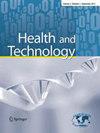Physical relief potential through robot-assisted mobilization in nursing care: an exploratory study
IF 2.8
Q2 MEDICAL INFORMATICS
引用次数: 0
Abstract
Abstract Purpose Physically demanding activities at the nursing bed are a key factor in the overwork of nursing staff and play a major role in the development of musculoskeletal disorders. The heavy back strain plays a significant part in this. Technical aids such as robotic assistance systems have the potential to minimize this overload during nursing activities. In the present work, we have investigated the relief potential of a supporting robotic assistance system developed in the AdaMeKoR project. An exploratory study design was developed to assess the relief potential of the robotic system for nurses during the care action of repositioning from the supine position to the sitting position at the edge of a nursing bed under kinaesthetic principles. Methods The study was conducted in March 2022 with a total of 21 nursing professionals participating. Safety precautions at this stage of the robot’s development made it necessary to use a 40 kg patient simulator instead of having a human act as the patient. Each participant performed the repositioning three times in the conventional manner and three times with the robotic-assistance. The conventional and the robotic-assisted task execution was compared using different perspectives of analysis. From a sensory perspective, ground reaction forces and electromyography data were collected and analyzed. A kinaesthetic perspective was added using 3D-video data which was analyzed by professional kinaesthetics trainers. A third perspective was added by collecting the subjective workload experiences of the participants. Results While participants’ self-assessment based on a NASA-TLX questionnaire suggests more of a physical and psychological strain from using the robot, electromyography shows a 24.41% reduction in muscle activity for left back extensors and 7.99% for right back extensors. The kinaesthetic visual inspection of the study participants also allows conclusions to be made that the robot assistance system has a relieving effect when performing the nursing task. Conclusions The conducted study suggests that overall the robotic-assistance has the potential of relieving nurses of partial physical exertion during mobilization. However, the different focuses of analysis show varying results in regard to external, i.e. sensor data and expert analysis, compared to internal, i.e. the nurses, perspectives. Going forward, these results have to be further expanded to get more robust analyses and insights on the interdependencies of subjective factors contributing to the experience of workload. In view of the fact that robotics for nursing is still a relatively new field and there are various lessons to be learned regarding the conceptualization of studies and corresponding evaluations, our approach of combining perspectives of analysis allows for a more differentiated view of the subject at hand.通过机器人辅助动员在护理中的物理缓解潜力:一项探索性研究
目的护理床上的体力活动是护理人员过度劳累的关键因素,在肌肉骨骼疾病的发展中起着重要作用。沉重的背部劳损在其中起着重要作用。像机器人辅助系统这样的技术辅助有可能在护理活动中最大限度地减少这种超负荷。在目前的工作中,我们研究了AdaMeKoR项目中开发的辅助机器人辅助系统的救援潜力。一项探索性研究设计旨在评估机器人系统在护理床边缘从仰卧位重新定位到坐姿的护理动作中的缓解潜力。方法研究于2022年3月进行,共有21名护理专业人员参与。在机器人开发的这个阶段,安全预防措施使得有必要使用一个40公斤重的病人模拟器,而不是让人扮演病人。每位参与者分别以传统方式和机器人辅助方式进行了三次重新定位。采用不同的分析视角对传统任务执行和机器人辅助任务执行进行了比较。从感官角度,收集并分析地面反作用力和肌电图数据。使用3d视频数据添加动觉视角,由专业的动觉训练师进行分析。第三个视角是通过收集参与者的主观工作量经验。结果:虽然参与者基于NASA-TLX问卷的自我评估表明,使用机器人会带来更多的生理和心理压力,但肌电图显示,左背伸肌肌肉活动减少了24.41%,右背伸肌肌肉活动减少了7.99%。研究参与者的动觉视觉检查也可以得出结论,即机器人辅助系统在执行护理任务时具有缓解作用。结论本研究表明,总体而言,机器人辅助具有减轻护士在活动过程中部分体力消耗的潜力。然而,与内部(即护士)的观点相比,不同的分析重点在外部(即传感器数据和专家分析)方面显示出不同的结果。今后,必须进一步扩展这些结果,以便对影响工作量体验的主观因素的相互依赖性进行更有力的分析和见解。鉴于护理机器人仍然是一个相对较新的领域,并且在研究的概念化和相应的评估方面有各种各样的经验教训需要学习,我们结合分析观点的方法允许对手头的主题有更不同的看法。
本文章由计算机程序翻译,如有差异,请以英文原文为准。
求助全文
约1分钟内获得全文
求助全文
来源期刊

Health and Technology
MEDICAL INFORMATICS-
CiteScore
7.10
自引率
0.00%
发文量
83
期刊介绍:
Health and Technology is the first truly cross-disciplinary journal on issues related to health technologies addressing all professions relating to health, care and health technology.The journal constitutes an information platform connecting medical technology and informatics with the needs of care, health care professionals and patients. Thus, medical physicists and biomedical/clinical engineers are encouraged to write articles not only for their colleagues, but directed to all other groups of readers as well, and vice versa.By its nature, the journal presents and discusses hot subjects including but not limited to patient safety, patient empowerment, disease surveillance and management, e-health and issues concerning data security, privacy, reliability and management, data mining and knowledge exchange as well as health prevention. The journal also addresses the medical, financial, social, educational and safety aspects of health technologies as well as health technology assessment and management, including issues such security, efficacy, cost in comparison to the benefit, as well as social, legal and ethical implications.This journal is a communicative source for the health work force (physicians, nurses, medical physicists, clinical engineers, biomedical engineers, hospital engineers, etc.), the ministries of health, hospital management, self-employed doctors, health care providers and regulatory agencies, the medical technology industry, patients'' associations, universities (biomedical and clinical engineering, medical physics, medical informatics, biology, medicine and public health as well as health economics programs), research institutes and professional, scientific and technical organizations.Health and Technology is jointly published by Springer and the IUPESM (International Union for Physical and Engineering Sciences in Medicine) in cooperation with the World Health Organization.
 求助内容:
求助内容: 应助结果提醒方式:
应助结果提醒方式:


